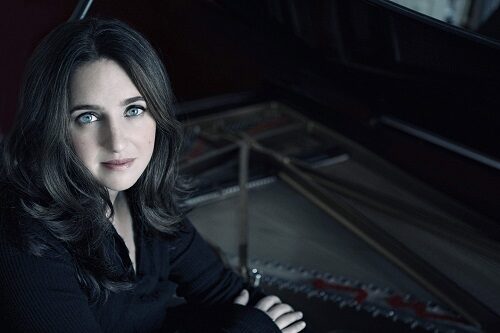 United States Bach: Simone Dinnerstein (piano), Eli and Edythe Broad Stage. Santa Monica College Performing Arts Center, Santa Monica, 27.3.2022. (DD)
United States Bach: Simone Dinnerstein (piano), Eli and Edythe Broad Stage. Santa Monica College Performing Arts Center, Santa Monica, 27.3.2022. (DD)

J.S. Bach – Goldberg Variations
Shakespeare’s private life may still be the least known and unquestionably most sought-after, but the life of Johann Sebastian Bach is not far behind: no diaries or memoirs, few letters to his children, little travel, all compensated for by an enormous output of written music.
The Goldberg Variations (originally called ‘an aria with different variations for harpsichord’) mark one of the many high points in Bach’s compositional output (an output which, one must agree, seems to have no ‘low point’). They were written at the request of Count Hermann Karl von Keyserling, a Russian diplomat whom Bach met in Dresden, to overcome the Count’s insomnia. Von Keyserling claimed that he ‘could not hear enough of them’ and, as a result, richly and generously rewarded Bach for the variations. Johann Gottlieb Goldberg was perhaps the first performer of this masterpiece.
It is a winning story, not only for von Keyserling but for all music lovers. My introduction to the Goldberg Variations came about while listening with one of my older brothers, who played his Glenn Gould LP discs regularly (and constantly) in the late 1950s and early 1960s. It reached a brotherly apogee with Gould’s second version of the Goldbergs some years later. In the past sixty years, the number of recorded versions has risen to three digits. (Fear not, pianists: the number of digits needed by most keyboard players has remained steady at 10.)
It has often been argued that the Goldberg Variations resemble an enormous passacaglia (in continuous variation form), and that assertion would receive no objection from me. They are created from a grounded bassline, topped by a progression of melodic passages that form the individual variations. In one of Bach’s most interesting musical projections, he designates that every third one will be a canon in its original key, with the exception of the heartbreaking Variation 25.
The pianist for this performance was Simone Dinnerstein, whom I now think of as the sensational Simone Dinnerstein, having heard her version of the Goldbergs. She performed an afternoon recital at the Eli and Edythe Broad Stage in Santa Monica. Although American, it was Dinnerstein’s Los Angeles debut and, as far as I could tell, the 499-seat theater was filled. The audience was asked to refrain from any applause throughout the performance which, thankfully, resulted in a superbly quiet audience, one that understood the ‘reasoning of quietude’ and acted accordingly. There was no intermission.
There was a deep sense of intimacy between Dinnerstein and the music. She took advantage of the piano’s breadth of dynamics, especially in the repeated sections. On more than one occasion she brought the softest sections to little more than a whisper. Her ornamentation was appropriate for her instrument and beautifully executed. The tempi were varied and always satisfying. For example, in Variation 13, a lesson in delicacy, the subtlety of the dissonance amidst the three melodic lines lead to a continuous grasping for closure, with a rhythmic dance leading to the final measures where the melodic lines search for resolution (and, for me, a continuous grasping for the Kleenex box). The opening and closing Aria may have been too slow for some, but I found it to be an exercise in deep contemplation. The return to the Aria at the end of the variations brought to a close a journey that I am happy to take repeatedly.
There is no ‘best’ variation as each one seems to be perfectly placed: the order is thoughtful, seamless and without fault. Each one grabbed the attention of the listener in its own way. Dinnerstein’s mastery of the piece is without question. When she made the very rare technical mishap, her recovery was immediate. She brought novel ideas to her interpretation and pianistic virtuosity to this most demanding composition. It was a concert I was glad not to have missed.
Douglas Dutton
